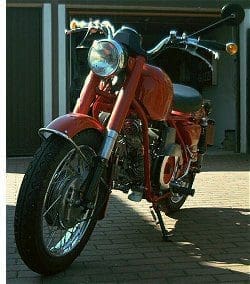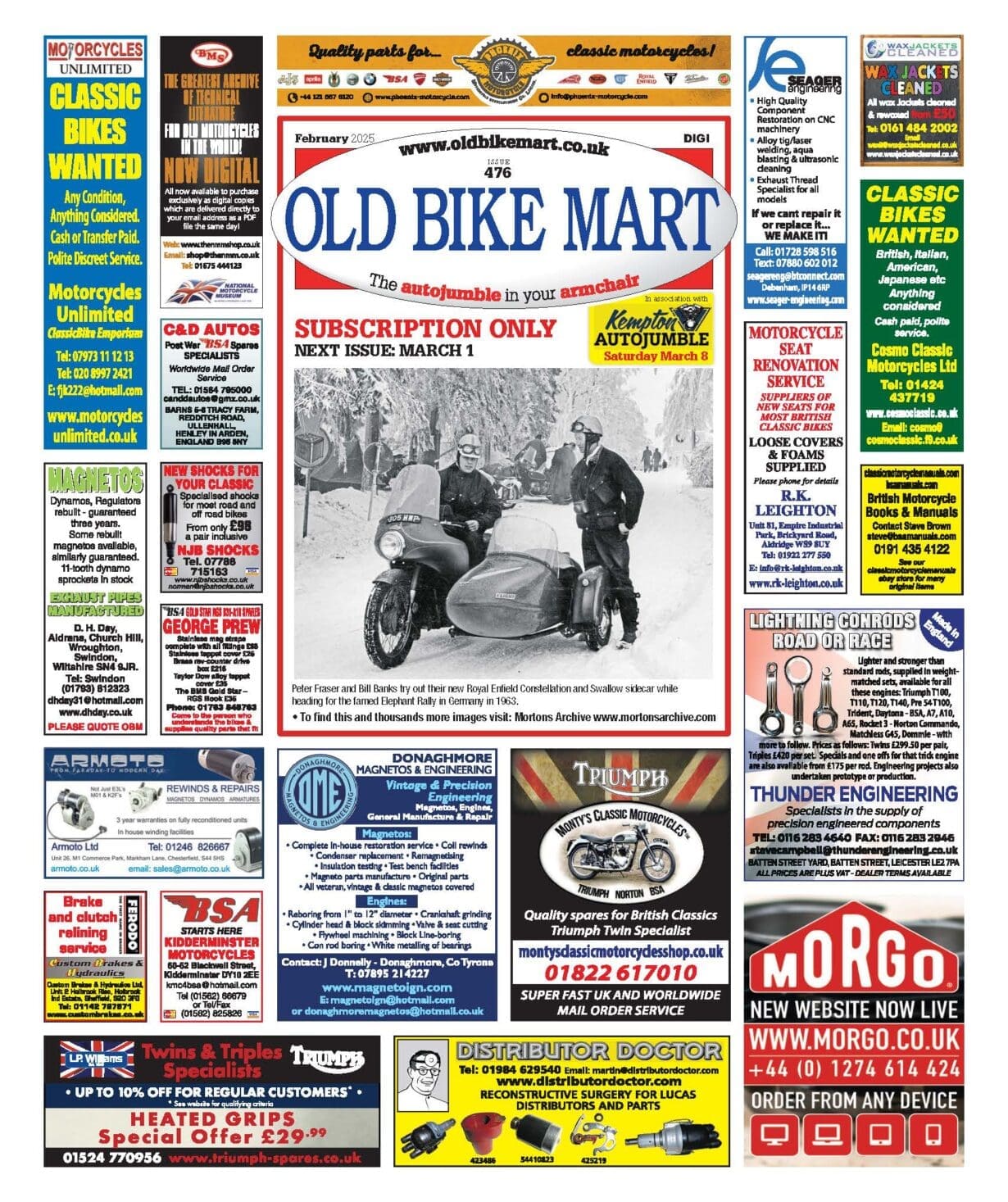Ask and ye shall receive! Classic Bike Mart readers want more information about the Moto Guzzi Nuovo Falcone, and few know more than Paul Friday
The bike that made the Guzzi name was a flat single. Long before they turned to industrial twins, Guzzi ruled the race tracks with small, light and quick singles. They used the same basic engine design throughout: a horizontal cylinder pointing forwards, an external flywheel and unit construction. Because the cylinder pointed forwards, it made the engine very long (just ask Ducati). To keep it sensible they made the crankshaft very compact, and squeezed it up very close to the gearbox. As a result, there was very little flywheel mass. To compensate they hung a flywheel on the end of the crank, where its perimeter could safely overhang the gearbox shafts. It also made a nice shoe-shiner if you put a sheepskin polishing mop over it.

It may have looked crude, but it meant that the rest of the bike could be very low thus giving it a small frontal area. They were so successful in racing that even Norton tried a copy of the design. But the world moved on. The Japanese started selling multi-cylinder rocketships with electric start. 2-strokes ruled the traffic light Grand Prix and the smell of burned oil was good for you.
So when Moto Guzzi sat down to design a sturdy and practical single-cylinder bike, what did they do? Did they revise their sophisticated Lodola with its overhead camshaft and ISDT heritage? No, they re-invented the Falcone. Only they forgot the famous maxim ‘add lightness and simplify’.
In the same year that you could buy a Honda 750-4 or a Kawasaki 500-3, Moto Guzzi announced the New Falcone – a 450lb thumper that developed 26 horses and wheezed up to 80mph. This was more power than the old Falcone made in road guise, but it carried more lard too. It may not have found many friends in the public, but it mobilised the Italian police and Army, and those of all their neighbours.

So what is it?
It’s a very old looking 500cc 4-stroke single. There is a pillion seat, but it’s perched up on the rear mudguard, bolted to the radio rack. There was a civilian version that had a proper dual-seat and tank taken from the V50, but it is rare. The engine follows the heritage with a massively-finned pot poking out the front of the frame tubes. The flywheel is still external, but almost hidden with a large dry cover. The flywheel itself weighs 20lb, and is a thing of beauty to behold as the bottom edge can be seen spinning below the left footrest at tickover. The same flywheel drives a Bosch dynamo though a rubber belt, following the best car practice. And this is no Lucas job either, but an honest 150-watt unit with a proper regulator. Some of the civilian versions used a different dynamo that could be run as a motor to provide an electric start. I’m not sure how successful that would have been though, as trying to kickstart it against compression is just like climbing a tall stair – the rider stands on the end of the lever looking over next door’s hedge and nothing else happens.
 This is not one of those nasty and vindictive British singles that breaks your ankle though – this is an Italian pussy cat. Ease the huge piston over TDC on the decompressor – the second clutch lever on the left ‘bar – and that flywheel just needs to be set in motion to take it over the next stroke and make it fire. And then all hell breaks loose. The standard silencer is, well, Italian. Left on a fast idle, the bike will walk around on its centrestand. Once warmed up and dropped to a standard idle, it ticks over so slowly that you find yourself waiting for the next bang. The engine is very low-revving – maximum power is at 4800rpm and the flat torque curve seems to peak somwehere around 3900. On standard gearing the engine fires just 1800 times a mile [Fantastic. That’s about once a yard. Could this be a new measure of “classic-ness”? CBMart]. It will chuff up the steep hill near my house in third, with each gasp of the carburettor clearly audible and followed by the boom of the exhaust. Each power stroke makes the front end jump slightly.
This is not one of those nasty and vindictive British singles that breaks your ankle though – this is an Italian pussy cat. Ease the huge piston over TDC on the decompressor – the second clutch lever on the left ‘bar – and that flywheel just needs to be set in motion to take it over the next stroke and make it fire. And then all hell breaks loose. The standard silencer is, well, Italian. Left on a fast idle, the bike will walk around on its centrestand. Once warmed up and dropped to a standard idle, it ticks over so slowly that you find yourself waiting for the next bang. The engine is very low-revving – maximum power is at 4800rpm and the flat torque curve seems to peak somwehere around 3900. On standard gearing the engine fires just 1800 times a mile [Fantastic. That’s about once a yard. Could this be a new measure of “classic-ness”? CBMart]. It will chuff up the steep hill near my house in third, with each gasp of the carburettor clearly audible and followed by the boom of the exhaust. Each power stroke makes the front end jump slightly.
Each gearchange makes your teeth clench slightly. Despite its charms, this bike was built to be ridden by cops and squaddies. The gearbox is massively strong but slow-moving. The flywheel mass means that the engine takes time to lose revs during a gearchange. Hurrying the box means a false neutral or a noise like two tanks colliding. You can change smoothly, but it must be learned. It took me two years.
Everything else on the bike is beautifully made, but over-engineered. It looks like a two-wheeled Humvee. Where the Japanese might have used a bit of thin steel pressing, the New Falcon will have an alloy casting or a bit of welded steel. Where older Japs ran steel shafts in alloy castings, the New Falcon uses bearings and bushes throughout. Parked next to a pal’s R1, it looks like a wrestler next to a ballet dancer.
Riding the New Falcon is unhurried. It will just about beat a car away from the lights if you spin the flywheel up and dump its energy to the rear tyre. The car will then pass you as you roll a fag between gearchanges. It will just about reach 80mph, providing there is no headwind or hill to climb. Motorways mean slip-streaming lorries. A and B-roads are fun though. The roadholding is actually rather excellent, and that throbbing exhaust just begs to be bounced off hedges and dry-stone walls. The lights are half decent, the electrics work and the brakes are pretty good once fettled. It all makes a kind of alternative sense.

Mechanically they suffer from few problems. The main one is the exaust valve seat, which is known to drop out if the bike is run lean. Get it converted to unleaded though, and the problem goes away. Change the oil frequently and just ride it. Most of the spares are still available off the shelf, from Holland or Italy.
You can also buy them almost new. The Italian Army seems to have been issued thousands of the things, ridden them for a month and put them in warehouses. You can buy an almost-new bike with just a few thousand km on the clock for less than the cost of a restored Bantam. You could buy a second one for spares and still spend less than some people pay for sad old Triumphs.
And the last laugh belongs to the New Falcon. While all its Japanese contemporaries have expired and all its British ones gone for landfill or become dubious restorations, you can still hit the highway on a barely run-in chunk of Italian heavy metal. Perhaps not a bat out of Hell, but certainly the turkey from Heck.
Need to know more about the Falcone? Try here: nuovofalcone.createaforum.com or www.facebook.com/groups/MGNFVOC/
Wanna buy a Falcone? These guys normally have them in stock or can track one down for you:



